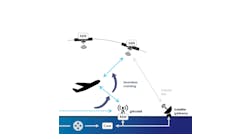The Wide World of Wi-Fi
Wi-Fi on the ground isn’t the same as in the air. The Wi-Fi in a person’s home refers, generally, to a specific family of wireless network protocols used for the local networking of devices and internet access. In a jet, Wi-Fi stands simply for wireless communication.
“People sometimes generalize that we put 'Wi-Fi’ in the airplanes. In aviation, Wi-Fi is really just a wireless connection to an access point and then the ability to get on a network,” explained David Salvador, vice president of aftermarket channel sales, Gogo Business Aviation.
There are two forms of connectivity in aviation today, air-to-ground (ATG) and satellite. Gogo is the only provider today offering ATG connectivity, Salvador said. While satellite connectivity is available from a handful of providers who use Ka- and Ku-bands as the two staple options.
The difference between the options comes down to three key things, James Person, senior director of business development for Viasat's Business Aviation division, said.
“It's cost, coverage and capacity of the network, which translates to speed for the user,” he said.
There are, of course, differences between ATG networks and satellite networks, with advantages and drawbacks to both. Finding the right fit for an aircraft is dependent on the type and size of the aircraft and its mission – where it will most often be flying and what the passengers onboard will be wanting out of their Wi-Fi.
For satellite, the Ku-band is the older of the two and uses lower frequencies than Ka-bands, giving Ka-bands a leg up when it comes to bandwidth. Though there’s more to deciding what to equip an aircraft with than bandwidth alone.
John Peterson, vice president and general manager of software and services at Honeywell Forge, said there are two areas people and their planes fall into.
“There are two things that an aircraft owner is looking for. One is entertainment and two is productivity,” said Peterson. “Your productivity customers, the time on the aircraft is time to be spent getting caught up and keeping the business running. Your entertainment customers, they’re people who get on the aircraft and it's leisure time for them, or they travel with family and they want to stream. So, their needs are quite a bit different, both in terms of the amount of speed they want and the amount of spectrum they need.”
For example, a larger aircraft with a global mission and high-productivity passengers, Peterson said a Ka-band connection, such as Honeywell’s JetWave system, is the right choice.
“They know that no matter where that aircraft is in the world, no matter what time of day it is, it is going to work exactly the same everywhere. And that is very important to a consumer like that,” continued Peterson.
Then for mid-sized aircraft that will be predominately flying regionally, such as only in the U.S., an air-to-ground system may be the right fit, Peterson said.
Air -to-ground systems work in much the same way as a cellphone does, bouncing signals from the device to towers located on the ground. Gogo’s 4G ATG network provides enough high-bandwidth for activities such as streaming video, video conferencing, or the ability to download large files.
“Our ATG network provides continuous coverage of all of the contiguous United States as well as portions of Canada and Alaska from 10,000 ft. above the ground level,” Salvador said.
L band is another kind of satellite communication, though older and slower than both Ka- and Ku-bands. L band solutions are much less expensive than Ka or Ku, and they are smaller and lighter options, so they can fit on a wider variety of aircraft types. L-band fits the mission of an operator who wants just a bare bone communication option.
Honeywell handles everything from L band, Ku- and Ka-band and air-to-ground, as well as producing routers and the software powering them.
“There is no one size fits all, we aim to make the passenger connectivity experience a productive or enjoyable one depending on the aircraft mission,” said Chris Moore, president of Satcom Direct (SD) Business Aviation. “Until recently the conversation has been about data speed into the aircraft, the conversation now revolves around what do you want to do with the data and this affects which system is selected.”
SD offers a full range of Wi-Fi solutions for mid- to large-size cabin aircraft as well as executive airliners, added Moore, and offers airtime from all the world’s leading suppliers including Inmarsat, Intelsat, Viasat and Iridium.
“We also manufacture the hardware, the SD router series including the SDR and SDR Gateway and supporting SD Wi-Fi hubs, which are designed to efficiently distribute the Wi-Fi signal throughout the cabin,” Moore said.
Person said that in Viasat’s experience, both mid- and super-mid business jets want internet without compromise, noting how important Ka-band is for the super-mid-size business jets.
Person described Viasat as “vertically integrated” in its offerings.
“We provide both the satellite network as well as the hardware on the aircraft. Our solutions are for super mid cabin and above. So, super mids and large range or long range, large cabin business jets. And we offer global Ku Advanced and we offer our high-speed Ka-band solution. And we can combine those two to our dual band solution in the large cabin aircraft,” he said.
Salvador said Gogo can address almost any budget and aircraft type and also the type of mission that the aircraft flies – anything from a single-engine turboprop all the way up to airline category aircraft that may be in a VVIP configuration. For VVIP aircraft Gogo offers a satellite system used by many airlines worldwide called 2Ku. The AVANCE platform is the underlying onboard technology that is the engine that drives it all.
“AVANCE is not just a connectivity solution, it’s a true digital platform consisting of both hardware and software. With AVANCE you can transform your entire inflight experience by integrating all five fundamental areas of aircraft connectivity and entertainment. That's productivity. It's efficiency, confidence, control and performance,” Salvador said.
Gogo AVANCE has two versions, the L3 and L5. The L3 is customizable with three service options available and offers a 3G experience, and the L5 offers 4G speed and bandwidth. Salvador noted that ANVANCE includes Gogo Vision built in, an entertainment option in business aviation delivering the latest Hollywood releases and TV episodes, among other media options, and is updated remotely when the aircraft is on the ground and the content is stored in the system onboard, freeing up bandwidth in the skies.
The Installation Process
While the Wi-Fi options an aircraft owner has to choose from are varied, installation is more straightforward – coming down to two factors – the size of the aircraft and the weight it can handle.
“Smaller aircraft will make use of smaller antennas – often called puck antennas as they are about the size of a hockey puck and deliver basic coms services through L-band connectivity. Super-mid to large-size and executive airliners will have the option to have a Ka-band option, whereas mid-size will most likely benefit from Ku-band options,” said Moore.
Salvador said their antennas and the onboard equipment are smaller and lighter than most satellite solutions.
Wi-Fi systems aboard a jet are made up of three components, an antenna, router and airtime. The antenna is responsible for transmitting and receiving the data from the satellite or air-to-ground system and the router is responsible for distributing the data received to the onboard devices. Airtime is then activated when those two initial installations have occurred. With the antenna is also the modem.
“[For satellites] the antenna goes up in the empennage, typically up in the T-tail, then the power supply and the modem get located usually in the avionics equipment bay, which does not have to be inside the pressure vessel,” Person said. “For example, in a super mid-size business jet aft equipment bay, we can put it back there and that's all it takes. The goal is to make it as simple and seamless as possible.”
Peterson notes that depending on the system an operator chooses, the hardware and installation will be different and with that so will the cost. Faster satellite systems like a Ka or Ku can cost as much as $600,000 whereas L Band systems can be half that. However, Person said Viasat’s Ku-band pricing is competitive with L Band system costs, and its Ka-band system offers the most capacity at competitive rates.
“The hardware differs – and that is one of the areas where the decision for the operator is complex – and it's extremely important they get it right and they balance it all out. So whether you choose a Ka system or a Ku system, which are your satellite based systems that have large tail mount antenna, or an L band system, which you could be a fuselage mount system or a tail mount antenna system, they have costs associated with them. And some of those costs can be, for some operators, quite high relative to the value it provides,” said Peterson.
“A big part of the consideration for which system to install is cost, and that is one of the biggest differentiators between ATG and satellite,” Salvador added. “ATG is a fraction of the cost of most satellite solutions of comparable performance, including the upfront cost of the hardware, the installation, and then the ongoing service plans – each of those are much more affordable with ATG compared to satellite.
For ATG systems, the antennas are mounted on the belly of the aircraft and Gogo offers different configurations depending on the system you choose. Installation costs for ATG systems are typically less expensive than for satellite. To help streamline the hardware and installation costs, Salvador said that Gogo purposely designed the AVANCE systems to have similar configurations.
“As an example, with the AVANCE L3, because we carried that 3G network forward, we utilize the same air-to-ground antennas that go on the bottom of the aircraft as the legacy ATG 4000 and 5000 systems. So, someone that wanted to upgrade into the AVANCE platform doesn't need to change those antennas that are already on the aircraft. The systems are made up of a single LRU, which in the case of AVANCE L3 is similar to size to the classic air-to-ground LRU,” Salvador explained.
Salvador added it’s important to note that installation on a business aircraft is a complicated process and requires a ton of expertise, engineering, certifications, and more.
“Our authorized, Gogo trained, dealer network and OEM partners are a critical part of our business. All of our products are only available through this authorized network for professional installation and activation to ensure the highest quality experience for our mutual customers,” he continued.
For operators whose plane is not equipped with Wi-Fi capabilities, but are looking to make the leap, installation of a system will almost always involves removing interior pieces of the aircraft and it’s recommended to have a Wi-Fi system installed at the same time as other avionics or interior work for that reason. On the maintenance side, systems will generally only require a visual check, at most, with software updates being the most maintenance heavy operations a system will undergo during its lifetime.
“We build our products with reliability and longevity in mind. Once a healthy installation is complete, there're very few times you ever have to go back and touch an installation, unless there may be a software update or something along those lines. That may be once or twice a year, and with the AVANCE systems we do it over the air, so no one physically boards the aircraft,” said Salvador.
“These are maintenance free items. There's no lubrication, no inspections that have to take place. Any software that gets updated on the modem, we can send over the air. So, it's non-touch in that sense. It's really quite easy. It's a set and forget type system,” added Person.
The cost and work involved with these installations should have an owner forward looking with their chosen system and thinking about the future of the technology.
“You need to know where technology is headed, so that you're assured that you can maximize the value of your aircraft in the future. You want to be very careful to not buy technology that is old and outdated,” said Peterson. “I'd recommend to an operator that it's worth it to spend a little bit more today, in order to get the right solution on the aircraft for the future, than it is to be penny wise and pound foolish, and to buy something that might be much lower cost today, but it's really not going to provide a good solution three, four or five years from now.”
And the future is around the corner. Gogo is building their 5G network now with a planned launch in 2021.
Viasat recently announced it removed internet speed limits delivered to the aircraft across all of its business aviation Ka-band service plans and is also currently designing it’s ViaSat-3 ultra-high capacity satellite system – a constellation of three additional satellites that will cover the world and offer the most Ka-band capacity for business aviation use, Person said.
And earlier this year, SD announced the launch of the SD Plane Simple antenna – moving the company into manufacturing the equipment needed to connect the cabin to the airtime service providers – with the Ku-band variant expected to be available for Supplemental Type Certificate in early 2021, followed by the Ka-band version later that year.





